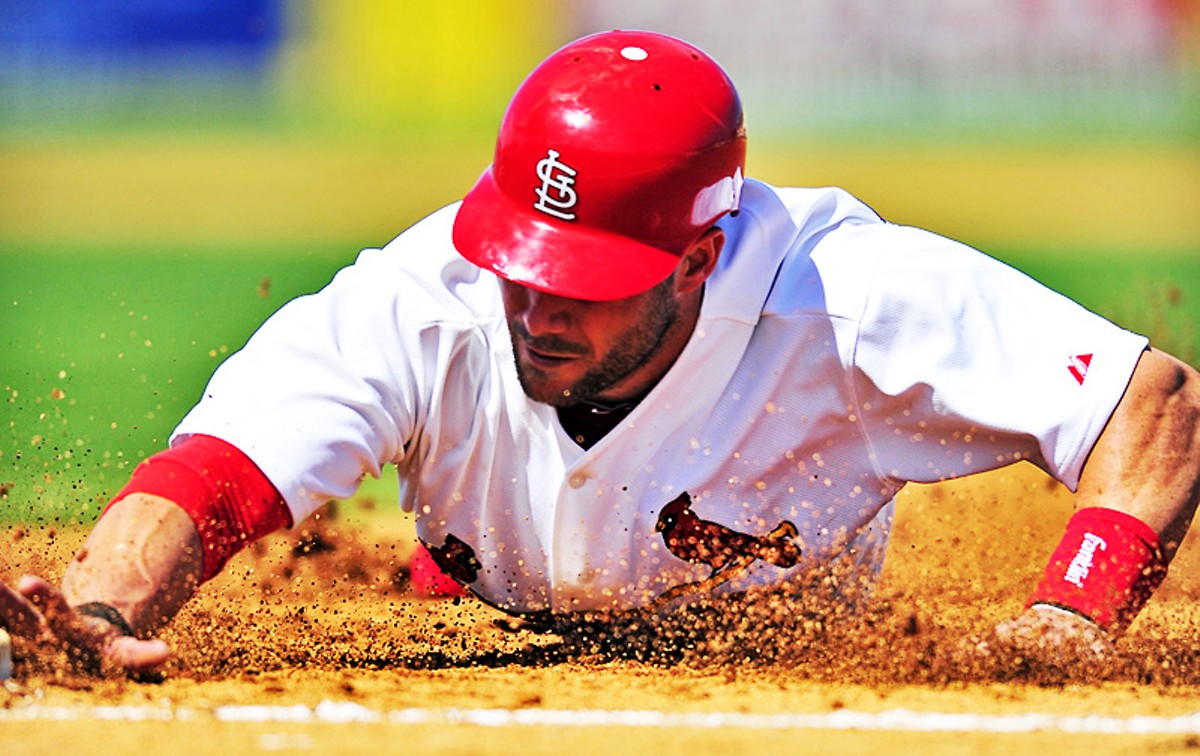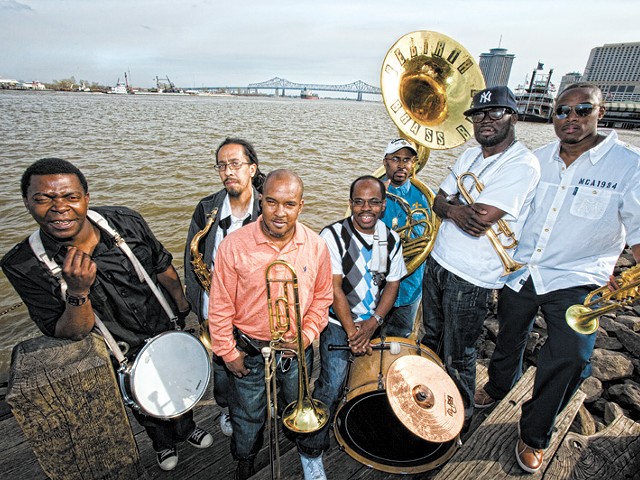You know how any time we have a presidential election in this country, you see maps everywhere? No matter what channel you turn to on the television, there's a map up. It shows red states. It shows blue states. And then it shows this tiny little group of states, much smaller than either of the other groups, states that just haven't quite made up their minds yet.
Swing states.
The really odd thing: Those swing states are somehow the only ones that really matter in the political process. All the other states are either red or blue, Republican or Democrat; they've made their minds up already. To toss out perhaps the world's worst cliché, they are what they are. They are quantifiable elements. The really important states are the ones that could go either way. Those are the states that ultimately decide who we'll all be complaining about for the next four years.
The Cardinals' roster this year is shaping up a bit like that big election map on television. Most of the elements of this team are pretty much set. We know Albert Pujols is going to hit .330, put about 40 balls over the wall and walk on water a time or two if he gets bored. We can be reasonably sure Matt Holliday is going to hit like an MVP candidate, win every game of "Who Has the Squarest Head?" played in the clubhouse and possibly burst out of his uniform while swinging at a curve in the dirt, Incredible Hulk-style. (He may also try to catch a humpback liner with his balls at some point, though it's probably best to leave that in pencil for now.) If Chris Carpenter is healthy, he'll be dominant. Ditto for Adam Wainwright.
The bottom line is this: The Cardinals come into the 2010 season with far more certainty at more positions than the past few seasons.
And yet much of this team's future will ride on the occupants of the few spots that are still up in the air. The players who could go either way. The swing-state players.
Colby Rasmus Let's start with the big one, shall we? Rasmus had a pretty nice 2009 season. He wasn't quite an all-star, but for a 22-year-old juggling huge expectations, big-league life, family strife and nagging health issues, Colby held his own. He played outstanding defense at one of the toughest positions on the field, showed plenty of raw power and hit respectably.
The question that remains is: How much more offense can we expect from this prodigiously talented young player? Most troubling last year was the downturn in Rasmus' walk rate. Walk rates have been shown to be fairly stable even as a player moves up the farm-team ladder; a player who's patient in the minors will likely remain patient. Rasmus, on the other hand, didn't take a walk for the entire month of June.
Still, there's much to be optimistic about.
Rasmus is likely to continue to play outstanding defense. If he stays right where he was in 2009 with the bat, he's Aaron Rowand. If he can raise his on-base percentage by 40 points or so, he's suddenly Steve Finley. And if he can somehow channel his 2007 self, when he hit .275/.381/.551 at Double A Springfield, he begins to look like Jim Edmonds — the man he was drafted to replace.
David Freese Freese did not have a particularly good off-season. An ankle injury suffered in an automobile accident before the 2009 campaign eventually led to surgery, which cost him a large chunk of the season. This past winter he went one better, getting arrested for drunk driving. Makes you wonder why he doesn't just stay away from cars entirely, doesn't it?
In 2010 the Cardinals are paying Albert Pujols $16 million, Matt Holliday $17 million and Chris Carpenter $14.5 million. That's $47.5 million to three players. With a projected Opening Day payroll of $95 million to $100 million, that's about half the money for about an eighth of the roster. Given that top-heavy payroll, in the coming years the Cards must find some production on the cheap.
Enter Freese, who is almost universally projected to be a perfectly acceptable, league-averagish third baseman at a bargain price. That will be a huge boon to a team that received wretched performances at the hot corner in 2009. Collectively, Cardinals third basemen hit .224 in '09. It's hard to imagine Freese could possibly be anything but an upgrade. After all, his lowest OPS at any stop in the minors is .884. Minor-league numbers are no guarantee of major-league success, but Freese's numbers aren't merely acceptable; they're elite.
The lack of buzz around Freese is mostly due to the fact that he was drafted later than most players. He was 23 when San Diego picked him in 2006 and was stuck on the Padres' depth chart behind more highly touted third-base prospects. In the St. Louis organization, he once again found himself low man on the totem pole, behind first-round pick Brett Wallace and the already-established Allen Craig. Now that he has outlasted Wallace and leapfrogged Craig, the Cardinals need Freese to step up and succeed.
Kyle Lohse After an '08 campaign that saw Lohse sign a long-term deal and then go out and have a career year, the 2009 season saw Lohse struggle with ineffectiveness and, for the first time in his career, injury. Lohse's ERA rose nearly a full run from 2008 to '09, from 3.78 to 4.74. His strikeout-to-walk ratio fell from 2.43 to 2.14. He was much more homer prone, giving up 1.22 home runs per nine innings in 2009 versus just 0.89 in '08.
The front of the Cardinals rotation is set, with dueling Cy Young contenders Chris Carpenter and Adam Wainwright forming one of the most intimidating one-two pitching punches in all of baseball. The only question mark for either is health, and prognosticating injuries is a fool's errand. Brad Penny, the Cards' latest project for Dave Duncan, is a lottery ticket. He could be worth his weight in gold (that's a lot of gold), or he could repeat his awful 2009 stint in Boston. The fifth starter is Jaime Garcia, and you never want to bank too heavily on the performance of a rookie, particularly a rookie pitcher.
What the Cards need from Lohse is a stabilizing influence in the middle of the rotation. They need him to be the guy they're paying him to be. His 2009 season was counterbalanced by Joel Piñeiro's unfathomable conversion from piñata to Dead Ball Era Superstar, but Piñeiro is gone. Another dud from Lohse will be much harder to weather in 2010.
On the other hand, if Lohse can regain his confidence, health and control, the Cards' rotation could move from solid to elite. The talent is there at the top, and there's a pair of intriguing arms at the back. All the rotation really needs is Kyle Lohse to function like the Dude's rug and tie the whole thing together.
Ryan Franklin Ah, the scary player. Of all the unknowns that could upset the Cardinals' apple cart, none looms so large as the Bearded One. To see the effect an unsettled closer's role can have on even a high-quality ballclub, one need look no further than the Cards' own recent history.
In 2003 the Cardinals had one of the most powerful offenses in all of baseball. It was the first year of the MV3, with Pujols, Jim Edmonds and Scott Rolen forming the engine of a run-scoring vehicle of awesome proportions. The bullpen that season, though, was awful, particularly early on when Jason Isringhausen was on the disabled list. The Cardinals missed the playoffs that year, as the pitching corps proved unable to hold the leads the offense created.
In both 2004 and '05, there was stability at the back end of the bullpen, with Isringhausen enjoying two fine seasons and Julián Tavárez handling the lion's share of setup duties. The next season, 2006, Izzy began his death spiral and very nearly pulled down the Cardinals along with him. Once Adam Wainwright was installed as closer, the bullpen stabilized, and leads became reason for optimism once more, rather than a sense of impending doom.
The most recent season sunk by a leaky bullpen was 2008, when Isringhausen again spent half his time battling injuries and the other half battling homeritis. The 2008 club led all of baseball in blown saves, and a season that could very well have ended in a wild-card berth instead ended in angry talk-radio rants. Last year Franklin was outstanding for most of the season, going whole months without giving up even a single run. Unsurprisingly, the team contended and ultimately won. The 'pen may not have been the biggest reason the Cards were once again the class of their division last year, but it certainly preserved the work the rest of the team did.
Really, that's the way bullpens in general, and closers specifically, tend to function. A great closer cannot make a bad team anything but bad, but there's no faster way to bring down a high-flying club than by losing leads late.
We saw Ryan Franklin at his best last season, when he seemed nearly untouchable, and we saw his slow implosion late in the season. He was awful in September, posting a 6.75 ERA and allowing opponents a 1.007 OPS. Think of it this way: In the month of September, Ryan Franklin essentially turned every hitter he faced into the Cardinals' version of Matt Holliday. And when the actual Cardinal Matt Holliday dropped a line drive in the playoffs, Franklin collapsed. The Nutshot Heard 'Round the League received all the focus, but Franklin needed to retire only a single hitter to preserve the win. Instead he allowed the next five hitters to reach base and the Cards' playoff hopes to slip away.
If the Cardinals want to be the elite club their top-end talent suggests they should be, there may be no more important player on the team than Ryan Franklin. The offense should plate plenty of runs, and at least two-fifths of the rotation should hand a lead to the bullpen nearly every time out. If those leads hold, the Cardinals will win. A lot.
If September 2009 Franklin shows up, though, it may not matter just how many of those states are already colored in. More than any other player on this year's squad, Ryan Franklin could swing the whole thing either way.






